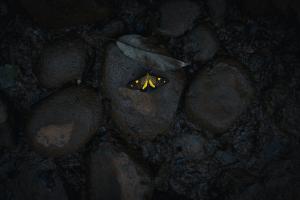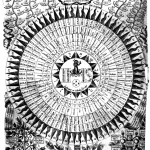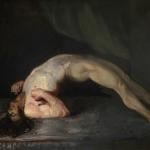 Until I was thirty-two, I was afraid to think about God. I panicked at what I called “ultimate questions.” In my journal when I was twenty-nine, I wrote: “Life-and-death is the only real drama. But I’m afraid to get close to it.”
Until I was thirty-two, I was afraid to think about God. I panicked at what I called “ultimate questions.” In my journal when I was twenty-nine, I wrote: “Life-and-death is the only real drama. But I’m afraid to get close to it.”
Yet I’d keep begging my husband George, teasingly, to “tell me the meaning of life.” It was one of the playful routines of the first six years or so of our marriage. We’d giggle at his lack of an answer—giggle because we were sure that any answer would be a religious cliché we’d scoff at.
We’d met while getting our doctorates in literature, and the thing in life we were most confident of—and quite arrogantly charmed by—was our own brilliance. If life did have a meaning, we were certain that we could find it (or produce it) in our own minds.
These certainties were our young-adult spin on the assumptions that had grounded our childhoods.
We grew up four hundred miles apart but in similar households, devoid of any mention of God. Our fathers were both doctors, with that faith in science which mid-twentieth century secularism had substituted for faith in God.
In the fashionable northeastern colleges where George and I each majored in literature in the 1960s, God was treated as a metaphor, product of earlier naïve ages’ need for a consoling transcendent reality. Taking the place of that reality was the human mind itself, the true source of meaning. Our graduate school English department was more of the same, celebrating mental performance. Our assigned papers became contests in crafting ice castles of the mind, showing off the intellectual structures glittering in the sunlight of our egos.
George and I lived in a happily self-absorbed cocoon during those early years of marriage. Creatures of our era, we gleefully embraced solipsism as our personal philosophy.
So we were titillated by Wallace Stevens’ clever positing of the problem of whether any reality existed apart from our mind’s construction of it—as in the opening stanzas of “Not Ideas About the Thing But the Thing Itself”:
At the earliest ending of winter,
In March, a scrawny cry from outside
Seemed like a sound in his mind.
He knew that he heard it,
A bird’s cry, at daylight or before,
In the early March wind.
The sun was rising at six,
No longer a battered panache above snow…
It would have been outside.
It was not from the vast ventriloquism
Of sleep’s faded papier-maché…
The sun was coming from outside.
In the late winter’s chill in which we were wrapped, George and I would crawl inside this poem together and amuse ourselves by tossing around its play between “the Thing Itself” and “Ideas About the Thing.”
With the poem’s protagonist, we’d hear that opening “scrawny cry” announced as a Thing Itself, a cry definitely “from outside.” But in the very next line we grinned as this definiteness dissolved and the cry “seemed like a sound in his mind.” The cry, the Thing, had been yanked away from outside reality into the realm of Ideas About the Thing. Yet even this placement wasn’t sure: it only seemed like a sound in his mind.
“He knew that he heard it,” but where he heard it—inside his mind or outside—was being toyed with by the poet. In either case, it was “a bird’s cry, at daylight or before,” heralding the sunrise.
Yet Stevens seemed to have brought the sun into the poem solely to continue playing these inside-outside games with it. “It would have been outside”; but was it? The game got an extra twist with the exotic metaphors offered in stanzas three and four—offered with one hand only to be pulled away with the other.
We were offered the sun as “a battered panache above snow,” but had it grabbed back from us by the negating phrase “No longer.” Ditto for “the vast ventriloquism / Of sleep’s faded papier-måché”: the poem lavished this metaphor on us only to deny its validity in the same breathe (“it was not”).
George and I gleefully applauded these now-you-see-it, now-you-don’t tricks. We’d laugh with the poem’s apparent subtext: that all was metaphor, the mind’s production. We gave little or no weight to Stevens’ own ambiguity about whether the difference between inside and outside could be resolved so easily.
Solipsism’s psychological manifestation is egotism. George found his way out of egotism’s claustrophobia sooner than I did. In the fall of 1975, he was denied tenure; this precipitated a crisis of self-esteem that eventually took the psychosomatic form of apparent heart failure, his way of manifesting the breakdown of his self-constructed self.
He began reading the Bible—and, amazingly, not to mock its metaphors but to search, desperately, for a foothold for hope in his crumbling life. Out of kindness to me, knowing that ultimate questions “freaked me out” (as we’d put it in the idiom of the day), he kept his Bible-reading to himself, never imposing on me his increasing mounds of earnest religious questions.
So when the Jehovah’s Witnesses knocked on the door one winter day, he welcomed them in, eager for conversation with biblical experts. Of course, they were delighted to teach the Bible to this unchurched young man ripe for conversion, so every week they’d return for a Bible study session.
I was glad that George had folks to talk with about something that mattered deeply to him, but I felt too threatened by the topic to let it continue under my roof. George lovingly obliged, moving the Bible study sessions that winter to our frozen front porch steps.
This began George’s journey out of the prison of self. My own breakout from egotism’s prison came later, and with the psychic violence that strikes Flannery O’Connor’s self-absorbed characters.
How it happened is another story—told in my essay in the current issue of Image (#77).
Peggy Rosenthal is director of Poetry Retreats and writes widely on poetry as a spiritual resource. Her books include Praying through Poetry: Hope for Violent Times (Franciscan Media), and The Poets’ Jesus (Oxford). See Amazon for full list. She also teaches an online course, “Poetry as a Spiritual Practice,” through Image’s Glen Online program.











